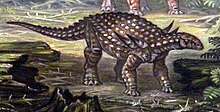Silvisaurus
| Silvisaurus Temporal range:Early-Late Cretaceous,
| |
|---|---|

| |
| Skull | |
| Scientific classification | |
| Domain: | Eukaryota |
| Kingdom: | Animalia |
| Phylum: | Chordata |
| Clade: | Dinosauria |
| Clade: | †Ornithischia |
| Clade: | †Thyreophora |
| Clade: | †Ankylosauria |
| Family: | †Nodosauridae |
| Subfamily: | †Nodosaurinae |
| Genus: | †Silvisaurus Eaton,1960 |
| Species: | †S. condrayi
|
| Binomial name | |
| †Silvisaurus condrayi Eaton, 1960
| |
Silvisaurus,from theLatinsilva"woodland" andGreeksauros"lizard", is anodosauridankylosaur from theEarlytoLate Cretaceousperiod. It is one of the only known dinosaur species named fromKansasand was designated the official state land fossil in 2023.[1][2]
Discovery and species
[edit]Afossilof the species was discovered in the 1950s by rancher Warren W. Condray of Wells, Kansas. He notified senatorFrank Carlsonwho directed him to the chancellor of theUniversity of Kansas,Franklin David Murphy.Murphy sent the preparator of the paleontology of vertebrates department of the natural history museum of the university, Russell R. Camp, to investigate the matter. In July 1955 Camp, with help from Condray, recovered the skeleton of a dinosaur. It was further prepared by Camp and Glenn H. Marihugh. In 1960 the find was described and named byTheodore H. EatonJr., also from the University of Kansas, as thetype speciesSilvisaurus condrayi.The generic name is derived from Latinsilva,"wood", in reference to the probably densely forested habitat of the animal. Thespecific namehonours Condray.[3]To date,Silvisaurusincludes only the type species.
Theholotype,KU 10296,was found in exposures of theTerra Cotta Clay Memberof theDakota Formation(lateAlbian-earlyCenomanian) inKansas,and consists of an incomplete skeleton with skull. It includes the mandible, eight neck vertebrae, ten dorsal vertebrae, asacrumof six sacral vertebrae, three tail vertebrae, a left pubis fragment, the lower end of the right femur, and a toe phalanx. Additionally disarticulated plates and spikes from the body armour were discovered. The condition of the fossil was poor as the bones had been exposed at the bottom of a dry riverbed and had been weathered and trampled by cattle. Some elements were only present as impressions or natural casts.[3]
Description
[edit]
Based on the remains, the animal is estimated to have been approximately 4 metres (13 ft) in length. Its skull measures 33 centimetres (13 in) in length and is 25 centimetres (9.8 in) wide. The bonysecondary palateis poorly developed inSilvisaurus,thedentaryincludes at least twenty-five teeth, the basal tubera of thebasioccipitalare bulbous, and eachpremaxillaholds eight to nine teeth.
The presence of teeth at the front of the jaw suggests that this may have been a relatively primitive nodosaur, since most later forms had a toothless beak instead. In addition to the usual rounded and polygonalosteoderms,Silvisaurusmay have also sported bony spines on its shoulders and tail. The head contained large air passages, which may have been used for loud vocalisations, presumably for communication.[4]
Classification
[edit]This taxon represents a relatively primitive nodosaurid, and Vickaryouset al.(2004) have stated that "Sauropeltaedwardsorum,Silvisaurus condrayi,andPawpawsauruscampbelliform abasalpolytomynested deep toCedarpelta."[5]
See also
[edit]References
[edit]- ^University of Kansas BIODIVERSITY INSTITUTE & NATURAL HISTORY MUSEUM, “Kansas Designates Silvisaurus Condrayi the Official State Land Fossil,” April 10, 2023, (https://biodiversity.ku.edu/kansas-designates-silvisaurus-condrayi-official-state-land-fossil)
- ^Liggett, Gregory A. (2005-01-01). "A review of the dinosaurs from Kansas".Transactions of the Kansas Academy of Science.108(1):1–14.doi:10.1660/0022-8443(2005)108[0001:AROTDF]2.0.CO;2.ISSN0022-8443.
- ^abEaton, T.H., Jr. 1960. "A new armored dinosaur from the Cretaceous of Kansas".The University of Kansas Paleontological Contributions: Vertebrata8:1-24.
- ^Palmer, D., ed. (1999).The Marshall Illustrated Encyclopedia of Dinosaurs and Prehistoric Animals.London: Marshall Editions. p. 158.ISBN1-84028-152-9.
- ^Vickaryous,Maryanska,and Weishampel 2004. Chapter Seventeen: Ankylosauria. in The Dinosauria (2nd edition), Weishampel, D. B., Dodson, P., and Osmólska, H., editors. University of California Press.
Further reading
[edit]- Vickaryous,Maryanska,and Weishampel 2004. Chapter Seventeen: Ankylosauria. in The Dinosauria (2nd edition), Weishampel, D. B., Dodson, P., and Osmólska, H., editors. University of California Press.
- Nodosaurids
- Late Cretaceous dinosaurs of North America
- Fossil taxa described in 1960
- Paleontology in Kansas
- Ornithischian genera
- Early Cretaceous dinosaurs of North America
- Thyreophorans of North America
- Late Cretaceous thyreophorans
- Early Cretaceous thyreophorans
- Albian genus first appearances
- Cenomanian genus extinctions
- Cretaceous Kansas

